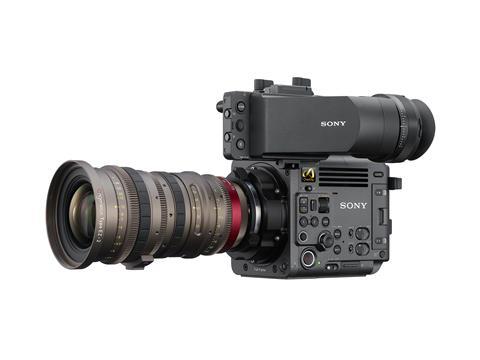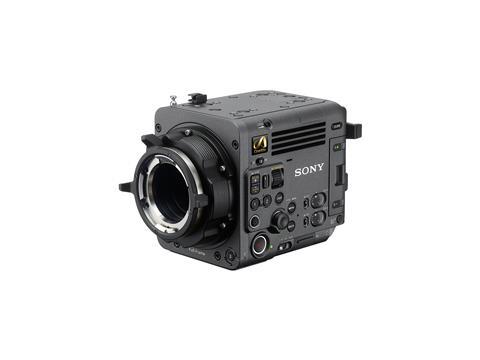It is part of the CineAlta lineup, alongside the popular Venice camera

Sony has announced the Burano camera, as part of its CineAlta lineup.
The camera slots into Sony’s top line of digital cinema cameras, featuring a sensor that matches the colour science of the Venice cameras.
The Burano has been designed for single-camera operators and small crews, providing CineAlta image quality with increased mobility. It’s also the first in the range to have a PL-Mount and in-body image stabilisation, as well as a thinner-than-before electronically variable ND filter.
When removing the PL lens mount, the camera can be used with E-mount lenses and supports fast hybrid AF and subject recognition AF, which is well-suited to fast-moving photography.
Sebastian Leske, head of business development, cinema, Sony Europe, said: “Burano is the perfect camera for both scripted and unscripted projects, be they for commercial, wildlife, or documentary productions, creating content that has a true cinematic feel, even when working with streamlined crews. This camera once again pushes back the boundaries of digital cinematography and is a wonderful addition onset alongside our existing digital cinema cameras.”

Thierry Donard, director and producer of extreme sports films, adds: “Two years ago, I wasn’t a fan of Auto Focus, now I can’t work without it. With other brands you don’t want to turn the camera off because it takes too long to come back on, but with this camera you can turn it off, and on, and immediately it works. One of the most challenging parts of the shoot was handing the camera back to Sony at the end, I really wanted to keep the camera.”
Burano features an 8.6K full-frame sensor that shares most of the Venice 2 specifications, enabling it to work alongside that camera in all types of productions. The sensor features dual-base ISO of 800 and 3200 and 16 stops of latitude. Sony says it produces “stunning images even in the most challenging lighting conditions”.
The camera has the ability to shoot at full-frame, Super 35, and includes a desqueeze function for anamorphic lenses, with up to 8K at 30 frames per second, 6K at 60 frames per second, or 4K at 120 frames per second.
Burano has a compact and lightweight body for high mobility, that’s around 32mm shorter and 1.4kg lighter than the Venice 2 camera.
It’s housed in a rugged magnesium chassis, making it suitable for filming in challenging environments.
The camera and accessory bags are made primarily of plant-based cellulose instead of plastic, as part of Sony’s efforts to be more environmentally conscious.
Burano has a newly developed image stabilisation mechanism and control algorithm that makes use of the advanced image stabilisation technology from the Sony Alpha series of mirrorless interchangeable-lens cameras to correct unwanted camera shake, such as movement from shooting handheld or walking.
The camera is equipped with an electronic variable ND filter from 0.6 to 2.1, enabling straightforward adjustments in various lighting conditions.

In addition, the electronic variable ND filter enables control of the depth of field with the iris and adjusts to the optimum exposure without changing the depth of field.
Chris Schmid, freelance director and cinematographer, nature documentaries, Switzerland, said: “The variable ND filter is crazy good. When you zoom the aperture changes and with one button you can switch in the ND filter to compensate, it’s so useful to me. When you look at the footage the dynamic range is very nice, you can recover the details from the shade of the trees while keeping the highlights, it’s not burnt and it’s amazing how the forest comes to life.”
Meanwhile, Burano implements design improvements based on feedback from the filmmaking community. For example, all menu buttons are positioned on the camera operator’s side. Additionally, tally lamps are placed in three locations to make it easier for the surrounding crew to check the shooting status.
The 3.5-inch multi-function LCD monitor can be used as a viewfinder, for touch focus, or menu control. The Burano also comes equipped with an optional robust T-handle, viewfinder arm, two 3-pin XLR audio inputs, and a headphone terminal (stereo minijack), convenient for solo operation.
The Burano can record from HD to 8K depending on the resolution, aspect ratio, and codec. It supports multiple internal recording formats, such as the new XAVC H for 8K, which uses the MPEG-H HEVC/H.265 high compression efficiency codec.
Other recording formats include XAVC and X-OCN LT. X-OCN is Sony’s original compressed RAW format that can capture information shot with 16-bit linear data, which gives filmmakers more freedom in post for colour grading. X-OCN LT can reduce file transfer time and storage size load, making post-production workflows more efficient than standard versions of RAW data.
The Burano is also equipped with two new CF express Type B memory card slots.
It comes with four new cinematic looks – Warm, Cool, Vintage, Teal and Orange, in addition to supporting industry standard s709 and 709 (800%) Look Up Tables (LUTs).
Burano can also be used for virtual production using large screen LED displays.
Paolo Sodi, director, cinematographer, nature documentaries, Italy, said: “When I touch the LCD screen to enable the touch tracking auto focus it works fantastically. You can use it handheld or by shoulder, all without a rig.
”I was able to work with the ND filter, with the autofocus, shooting at 4K, in slow-mo at 3200 ISO, and it all worked very, very well. When I switched on the camera it started fast – immediately it was on, and when I switch between 8K, 6K or 4K for slow-mo., it’s very fast. The image quality is fantastic, just fantastic.”
The Burano is expected to retail for around US$25,000 (£20,000).




























No comments yet